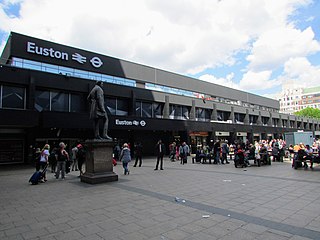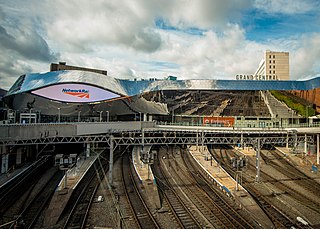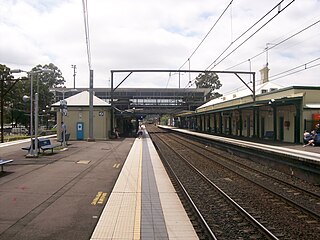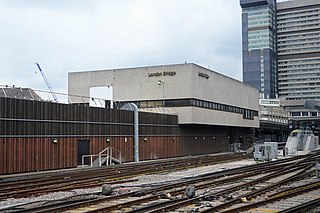
Euston railway station is a major central London railway terminus managed by Network Rail in the London Borough of Camden. It is the southern terminus of the West Coast Main Line, the UK's busiest inter-city railway. Euston is the tenth-busiest station in Britain and the country's busiest inter-city passenger terminal, being the gateway from London to the West Midlands, North West England, North Wales and Scotland.

Birmingham New Street, also known as New Street station, is the largest and busiest of the three main railway stations in Birmingham city centre, England, and a central hub of the British railway system. It is a major destination for Avanti West Coast services from London Euston, Preston, Glasgow Central and Edinburgh Waverley and West Midlands Trains services from Liverpool Lime Street and London Euston both via the West Coast Main Line. The CrossCountry network centres on New Street, as well as local and suburban services within the West Midlands; these include those on the Cross-City Line between Lichfield Trent Valley, Redditch and Bromsgrove, and the Chase Line to Walsall and Rugeley Trent Valley. The three-letter station code is BHM.

Gordon railway station is a heritage-listed railway station located on the North Shore line, serving the Sydney suburb of Gordon. It is served by Sydney Trains T1 North Shore line and T9 Northern line services. Situated at St Johns Avenue, Gordon in the Ku-ring-gai Council local government area of New South Wales, Australia, the station was designed and built by the New South Wales Department of Railways in 1909. The property was added to the New South Wales State Heritage Register on 2 April 1999.

York railway station is on the East Coast Main Line (ECML) serving the cathedral city of York, North Yorkshire, England. It is 188 miles 40 chains (303.4 km) north of London King's Cross and on the main line it is situated between Doncaster to the south and Thirsk to the north. As of June 2018, the station is operated by London North Eastern Railway. It is the busiest station in North Yorkshire, the third busiest in Yorkshire & the Humber, and the sixth busiest in Northern England, as well as being the busiest intermediate station on the East Coast Main Line. In Britain's 100 Best Railway Stations by Simon Jenkins, the station was one of only ten to be awarded five stars.

Northampton railway station serves the market town of Northampton in Northamptonshire, England. It is on the Northampton Loop of the West Coast Main Line and is located 65 miles 68 chains from London Euston. The station is served by West Midlands Trains services between London Euston and Birmingham New Street; there is also a limited direct service to Crewe. A handful of Avanti West Coast services also serve the station, but these have been greatly reduced due to the longer-term impact of the COVID-19 pandemic in the United Kingdom. It is the busiest station in Northamptonshire, and the fourth busiest station in the East Midlands.

Canterbury railway station is a heritage-listed railway station located on the Bankstown line at Canterbury, New South Wales, Australia. The station was designed by New South Wales Government Railways and built from 1895 to 1915 by J. J. Scouller. It is also known as Canterbury Railway Station group. The property was added to the New South Wales State Heritage Register on 2 April 1999.

Shrewsbury railway station serves the town of Shrewsbury, in Shropshire, England. Built in 1848, it was designated a grade II listed building in 1969.

Stafford railway station is a major interchange railway station in Stafford, Staffordshire, England, and is the second busiest railway station in Staffordshire, after Stoke-on-Trent. The station serves the market and county town, as well as surrounding villages. The station lies on the junction of the Trent Valley line, the Birmingham Loop/Rugby–Birmingham–Stafford line, and the West Coast Main Line.

The Leonardo Royal Hotel Birmingham is a hotel on Broad Street, Birmingham, England.

The Peterborough–Lincoln line is a railway line linking Peterborough and Lincoln, via Sleaford and Spalding. Between Lincoln and Spalding, the line follows the route of the former Great Northern and Great Eastern Joint Railway.

Penrith railway station is a heritage-listed railway station located on the Main Western line in the western Sydney suburb of Penrith in the City of Penrith local government area of New South Wales, Australia. It was designed by New South Wales Government Railways and the 1863 building was built by M. and A. Jamison and D. Forest. It is also known as Penrith Railway Station group. The property was added to the New South Wales State Heritage Register on 2 April 1999.

Muswellbrook railway station is a heritage-listed railway station located on the Main Northern line in Muswellbrook, in the Muswellbrook Shire local government area of New South Wales, Australia. The station serves the town of Muswellbrook and was designed by John Whitton, the Chief Engineer of NSW Railways. It is also known as Muswellbrook Railway Station and yard group and Musclebrook Railway Station. The property was added to the New South Wales State Heritage Register on 2 April 1999.

Banbury railway station serves the historic market town of Banbury in Oxfordshire, England. The station is a stop on the Chiltern Main Line; it is operated by Chiltern Railways and has four platforms in use.

Wellington railway station, Wellington Central station, or simply Wellington station, is the main railway station serving Wellington, New Zealand, and is the southern terminus of the North Island Main Trunk, Wairarapa Line and Johnsonville Line.

London Bridge Area Signalling Centre (ASC) was a signalling centre on the Kent Route of Network Rail, principally covering the line from London to Kent and Sussex route areas of Network Rail. The signalling centre was opened in 1974, and closed in 2020.

York Integrated Electronic Control Centre was a major signalling control centre on the East Coast Main Line railway between London and Edinburgh. The centre also contained the electrical control centre for the line and the LNE regional control office of Network Rail. Its responsibility for signalling across Yorkshire was transferred to York Rail Operating Centre in December 2018.

Ringway Centre is a Grade B locally listed building located on Smallbrook Queensway in the city centre of Birmingham, England. The six-storey, 230 metres (750 ft) long building was designed by architect James Roberts as part of the Inner Ring Road scheme in the 1950s and is notable for its gentle sweeping curved frontal elevation.

William Robert Headley was an architect who is best known for his modernist railway stations for the London Midland Region of British Railways in the early 1960s.
Paul Hamilton (1924-2004) was a British architect of Austrian origin.

York Rail Operating Centre is a Rail operating centre (ROC) located at the south western end of York railway station in York, England. The site is one of twelve that will control all signalling across the mainland of the United Kingdom. It was opened in stages from 2014 onwards, with responsibility for signalling becoming active in January 2015. The York ROC accepted the role of its predecessor, the adjacent York Integrated Electronic Control Centre (IECC), in December 2018.




















